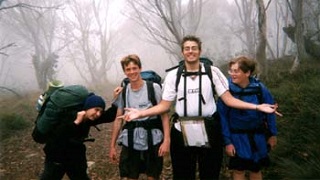
Very simply, hypothermia is the condition where the body is losing heat faster than its “internal furnace” can regenerate it. This loss of body heat causes impaired motor skills and judgement, and if untreated can be fatal. The main problem with hypothermia diagnosis is that we tend to think of it as a winter problem … we think of people “dying of exposure” after being lost in sub-zero temperatures. A cool, rainy day with a bit of wind during the summer can cause hypothermia also – it is important to be able to recognize the condition. We class hypothermia in two separate categories; mild and severe.
Mild Hypothermia
* Causes – Lack of sleep, lack of food (calories generate internal heat), wet clothing, cool temperatures, rain or mist.
* What Is It? – A body core temperature between 30?C and 36?C
* Symptoms – Shivering and cold, tiredness, personality changes, irritiability, sluggishness, poor coordination, lethargy.
* Treatment – Stop any further heat loss. :- get the person out of the wind and rain and get the person into dry clothes. :- Get the “internal furnace working again – feed the person hot drinks and high-calorie foods. :- Try to get the person to move around to generate heat. :- Add external sources of heat. Do not just place the person in a sleeping bag, since that person is not generating enough heat to re-warm himself. Add warmth in the form of warm water in Nalgene bottles; or by putting the person between two warm bodies.
Severe Hypothermia
* Causes – Severe heat loss from very cool temperatures or immersion in cold water
* What Is It? – A body core temperature below 30?C
* Symptoms – Shivering ends, pulse and respiration slow, coordination becomes very poor, speech becomes slurred and unconsciousness can result. Immediate treatment required to prevent fatality
* Treatment – Stop any further heat loss. : – get the person out of the wind and rain. :- Wrap the person in sleeping bags to help prevent any further loss. :- No food or drink – vomiting can occur. :- Add warmth in the form of warm water in Nalgene bottles in the groin and armpits. :- Handle the person very gently – when a person is in this condition, rough or agressive movements can cause their heart to go into ventricular fibrillation. :- Think about a plan to get the person to medical facilities as soon as possible .
Important Things to Know
* Mild Hypothermia can turn into Severe Hypothermia – Unless you add external sources of heat to replenish the missing internal heat source of a mildly hypothermic person, they will eventually slide into a state of severe hypothermia. Even mild hypothermia is a serious conditions which requires immediate treatment.
* The Best Treatment for Hypothermia is Avoidance – If conditions are conducive to hypothermia (cool, windy, damp) it is a good idea to watch all group members carefully. A mildly hypothermic person may seem quiet or sullen when in fact they are losing dangerous levels of body heat. If weather conditions are bad, talk to people to check on their condition. Be sure everyone is dressed appropriately (no cotton, layers of fleece or polypro, good rainsuits). Stop often to rest or to have a hot drink.
